In this article, we will be discussing what plants can be grown for sunny and dry conditions.
We all know the scenario, we have a long, dry summer (I know these are rare and we must not complain when we get one), and most of our plants are wilting or worse dying. Is this the fate of our plants? or are there some plants that have some resistant to the drought?
Are there some plants that do well if they are not watered as frequently? The answer to these questions is yes, plants do exist that can survive with less watering.

To be truthful, no plant can survive too long in dry compost and this is why water-retaining gels are a blessing. This means watering is always needed in periods where rain has not been seen for a long time.
These plants which I about to show not only like the sun but can revel in dry conditions, as long as it is not too prolonged, Plants always need water, Is just some need more water than others.
What follows are plants that do well in the sun and in dry conditions in containers:
ALYSSUM

There are two distinct groups of plants that belong to the Alyssum species; the bedding and perennials. Bedding alyssums are the ones to grow, where they are hardy annuals to provide a floral edging around other flowers. The bedding Alyssum grows up to 15cm in height where tiny honey-scented pink, white, purple or red flowers appear.
It is best to sow seeds in February under glass before planting out in May after the final frosts have passed.
Grow these plants in well-drained multipurpose compost.
ARCTOTIS (African Daisy)

This showy plant has a catchy display of white, yellow, blue, orange, red and purple daisy-like flowers on long branches. This 45cm tall annual produces 7.5cm large bloom in summer to autumn.
Grow this plant in well-drained, sandy, multipurpose compost, where you will need to sow seeds in March before planting out in its final location in late May.
CALANDRINIA (Rock Purslane)
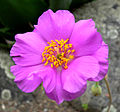
This 15cm tall tender perennial that is often grown as a half-hardy annual. It is a low-growing, matt-forming plant that will provide as an edging plant in containers.
The magenta bowl-shaped flowers appear in summer, which lasts for a day or two. The flowers are borne over grey-green leaves.
Grow it in a sandy multipurpose compost in a sheltered area.
CALENDULA (Pot Marigold)

This old Favourite once widely used as a potherb is now used as an annual. This 60cm tall plant produces single, semi-double or double flowers over narrow green leaves. Flowers are produced from late spring to early autumn, which comes in oranges, yellows, or from cream to red.
Plant seeds in January to March under gentle heat before planting out in April to May, It only takes 10weeks from sowing the seeds before the flowers appear. It is best to pinch out growing tips to encourage plants to bush out, whilst deadheading regularly will prolong the flowering season.
Plant in a multipurpose compost where it will quickly thrive.
CELOSIA (Prince of Wales Feathers)
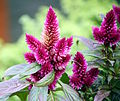
There are two types of flowers heads; the plume types and the crest types. The former can be grown outside if the weather is warm and in a sheltered site.
It can grow up to 90cm in height, where on top of narrow, green leaves, plumes of white, yellow, orange, red, or purple are produced in summer.
The crested Celosia are not hardy and are only suitable to be grown indoors. Sow seeds in February-March before planting our in a warm and sunny spot in sandy, multipurpose compost.
COREOPSIS (Tickweed)

This is a hardy annual or a border perennial depending on the species that is grown. C. tinctoria is the usual annual special, whilst C. verticillata is the usual perennial variety.
It is a free-flowering plant that produces large, marigold-like flowers in yellow, orange and red. The flowers are produced in large number over long, narrow light green leaves, where it can grow up to 90cm in height.
Sow seeds in March in gentle heat for the annuals and plant out in May. Perennial in any pots can be planted out any time. Plant them in a well-drained multipurpose compost in full sun.
COSMOS

This is a popular annual that has delicate, fern-like leaves and large flowers that are borne on thin stalks. The flowers are traditionally white or pink but varieties have been breed include ‘Candy-stripe’, which is red blotched. ‘Ladybird’ produces yellow flowers, whilst ‘Flat Chocolate’ produces a dark red, chocolate colour with a chocolate scent.
Sow seeds of this 90cm tall plant in March –April under gentle heat before planting out in late May. Grow in a sandy, well-drained, multipurpose compost in a sunny spot.
DIMORPHOTHECA (Star of the Veldt)

The Latin name may be difficult to pronounce but the plant is a beauty.
This hardy annual can be said to be one of the most drought-resistant of all bedding plants. To do well you must plant this annual in the right location in full sun. Any shade and the flowers will refuse to open.
This 30cm tall plant originates from South Africa, where scented white, yellow, orange, or pink flowers with dark centres are borne in summer.
Sow seeds in April, where they are to flower or sow indoor in March and plant out in late May in a sandy, well-drained multipurpose compost.
ESCHSCHOLZIA (Californian Poppy)

It is easier to grow this annual than to spell its Latin name. All you need to do is sprinkle seeds in a container in autumn or spring, lightly cover and then enjoy the show in the summer months.
The flowers are borne over blue-grey, deeply divided leaves, where the flowers flutter in the breeze.
The flowers come in a variety of colours from yellow, white, red, orange, or cream. It can grow up to 30cm in height.
You must grow in-situ as they hate any root disturbance when the seeds are planted in a well-drained multipurpose compost in full sun.
FELICIA (Kingfisher Daisy)

This 45cm tall annual is from South Africa and so will need full sun and good drainage to succeed. The narrow, dark green leaves are covered with blue flowers with yellow centres that appear in mid-summer and early autumn. Like all South Africa daisies, it will close in dull weather.
Sow seeds under gentle heat in March and plant out in late May. Grow it in well-drained, multipurpose compost.
GAZANIA

This 45cm tall half-hardy annual is quite showy. Over dark green. Narrow leaves, large daisy-like flowers with dark central ring around the plant’s eye.
The flowers come in a large variety of colours that come in all sorts of combinations (blends, stripes, contrasting zones, etc.). The flowers appear in July to October, where they open in bright sun and closes in dull weather.
Sow seeds in February-March in gentle heat and then plant out in late May. Grow this plant in well-drained, multipurpose compost in full sun.
GOMPHRENA (Globe Amaranth)

This is worth raising from seed of you are into flower arranging with dried flowers. This 30cm tall plant has narrow, green leaves, where on tall stalks ball-like pink, red, or purple heads are borne. The flowers provide useful, cone-shaped blooms to your dry flowers display, where it can last for a long time.
To grow this attractive plant sow seeds in February in gentle heat and plant out in late May. Grow this plant in well-drained multipurpose compost.
HELICHRYSUM

The annuals produce flowers that last a long time, where double daisy-like blooms are borne on short stems. The narrow, light green leaves are insignificant but the flowers of yellow, white, orange, pink, red, or purple that makes the plant. The flowers are produced in the summer months.
The perennial Helichrysum tends to be small, where the leaves are more noticeable. Annuals tend to be more spectacular than the perennials.
For the annuals sow seeds in March under gentle heat and plant out in May in a well-drained, multipurpose compost.
MESEMBRYANTHEMUM (Livingstone Daisy)

One of the longest name for such a beautiful plant. It is one of the brightest of all annual, as long as the sun is shining and the compost is light.
If you cannot meet these requirements then it is not worth growing this annual. Daisy-like flowers are borne on short stems on top of small, succulent –like leaves.
Sow seeds in March under gentle heat and plant out in late May.
Grow this beautiful plant in well-drained, sandy, multipurpose compost.
PETUNIA
One of the most improved bedding plant, as once all you got was dull flowers and straggly plants.
This is no longer the case, where a wide range of colours and flower sizes are possible. It can have an upright habit, spreading habit or trailing habit. This progression has made petunias the most popular bedding plant, as their spreading and trailing habits makes them ideal for window boxes, containers and hanging baskets.
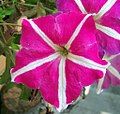
All plants produce flowers over light green, oval-shaped, narrow leaves in abundance. The colour range of flower are astounding, and they can be monochrome, bicoloured, multi-coloured or striped.
Petunias like hot and dry conditions, where the display may be disappointing in cool, wet summers.
You can start from seed but they need a high temperature (21 degrees Celsius to 24 degrees Celsius) to germinate. This can only be achieved via a propagator or heat mat inside your home. If you cannot manage to do this, you can buy plug plants in spring, ready for planting out once the final frost has passed.
Try to buy plants that have not flowered yet, as this will produce the best displays. Plants can become straggly over time and so may need cutting back to produce new shoots and new flowers.
Deadheading is a must to get a succession of blooms. Slug protection and regular feeding is also a requirement.
TYPES OF PETUNIAS
Petunias come in four groups; the multifloras, the grandifloras, the millifloras, and the surfinias.
Multifloras grow up to 45cm in height, it is the recommended bedding variety, which produces masses of small flowers and will do much better if it has been raining.
Grandiflora produces 13cm wide blooms that are borne less freely and it grows less vigorously.

Millfloras produce masses of 3cm blooms in diameter and have good resistance to excessive rain.
The surfinias are the true trailing variety of petunia that produces 1.7m long stems. They are propagated with root cuttings and not seeds. They come in a large variety of colours and a firm favourite for planting in hanging baskets.
Sow seeds in January to March in a temperature of 21 to 24 Degree Celsius, and plant out in late May. Grow these plants in a well-drained, sandy, multipurpose compost.
PHLOX
Phlox come into two different groups; the annuals and the perennials. This prolific flowerer produces blooms of white, pink, blue, lavender or red throughout the summer months.

The blooms are born on top of tiny, narrow green leaves.
P. panculata is the popular perennial variety, which grows up to 60cm in height.
P. subulata and P. douglasii that grows up to 45cm in height are popular annuals, so is P. drummondii.
For the annuals sow seeds in February and March in gentle heat for planting out in late May. Grow this favourite in enriched, well-drained, multipurpose compost.
PORTULACA (Sun Plant)
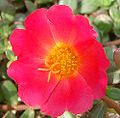
This 15 cm tall half-hardy annual produces semi-double blooms in many colours. This ground-hugging plant has reddish stems of fleshy-like green leaves that are almost totally covered with flowers.
Sow seeds in February or March in gentle heat, and plant out in late May.
Grow this annual in well-drained, sandy, multipurpose compost.
SALVIA (Sage)
There are several types of salvias; annuals for the beds, evergreen and deciduous hardy perennial, and herbs for the kitchen. All sages produce attractive, oval-shaped leaves that can be variegated.
The most common annual sage is S. splendens, which provides a vivid red, which is matched with white and blue flowers in these bedding schemes.

S. coccinea is another bedding plant, which has more subtle red or pink coloured flowers.
S. horminum (Annual Clary) is grown for its colourful bracts and for its purple and pink flowers.
If you noticed all annual sages’ produces red, pink or purple flowers, but there is one exception S. Farinatea, which produces a blue coloured flowers on tall, erect spikes.
Annuals tend to flower between July and October.
The perennial salvia is less grown in people’s garden. They produce hooded tubular flowers that come in hues of blue or lavender. These blooms are bone on slender spikes around the think grey-green leaves.
There are numerous varieties that cover these groups, where they tend to flower between May and August.
Evergreen sage are the culinary sage, which is grown for its leaves and not the lilac flowers that appear in summer.
For annuals sow seeds in February and March in heat (around 21 to 24 degree Celsius). Plant out in late May in a well-drained multipurpose compost.
TAGETES (Marigold)
These are the flowers to grow if you want yellow, oranges and reds in your bedding schemes.
There is much to like; the plants are easy to grow from seeds, reliable under all growing conditions have a long flowering time, and are inexpensive to buy from seeds or seedlings.

There are 4 groups of Tagetes that can be grown; the Tagetes varieties, the French marigold, African marigold, and Afro-French marigold.
All of these plants have deeply divided green leaves from which on top of short stems, single, semi-double, or double flowers are produced.
The shortest group is the Tagetes varieties, which grows up to 23cm in height, which produces masses of single flowers. The popular French marigold produces colourful bloom from white to deep red. The flowers can be single, semi-double, or double, and appear on top of bushy plants that grow up to 30cm in height.
The African marigolds are much taller growing up to 90cm in height. It produces larger bloom but less of them appear compared to French marigolds.

In between the French and African marigolds, you have a hybrid of the two. They grow up to 45cm in height, where larger blooms than French marigold are borne but in larger number than African marigolds.
All marigolds flower from June to the first frosts.
Sow seeds in February to March and plant out in late May. Grow these annuals in multipurpose compost. It is best to plant the seedlings out before the flowers open. You may need to protect them from slug damage, and tall varieties will need staking to prevent them from flopping all over the place.
Deadheading is also required to prolong the flowering period.
TROPAEOLUM (Nasturtiums)
This covers a number of annuals include Canary Creeper and perennial species. The Nasturtiums cover all purposes; climber for walls, scramblers for slopes, semi-trailers for window boxes, and dwarf varieties for bedding and hanging baskets.

T. majus grows up to 15cm in height and 2.4m long. It produces trumpet-shaped flowers of red, orange and yellow from June to October. ‘Tom Thumb’ and ‘Twirlybird’ are dwarf varieties of the trailing type.
T. peregrinum (Canary Creeper) is the annual climber that has yellow, bird-shaped flowers and palmate leaves, which make it different to the round leaves often seen by the trailing varieties.
T. speciosum is the perennial variety growing up to 45cm in height, where large red blooms are produced in July-September. Alternatives include T. tuberosum ‘Ken Aslet’ and T. polyphyllum, which is a tender plant that should be lifted in autumn and replanted every spring each year. It flowers in June and July, where it grows up to 1.4m in height.
For annuals sow seeds in April in Containers where they are to flower, or you can grow them in a greenhouse under heat for planting out in May. Grow this plant in a well-drained multipurpose compost.
URSINIA

This is another colourful South African daisy what will brighten up any container display in mid-summer. This 45cm tall annual produces daisy-like flowers that come in shades of yellow or orange. At the base of each petal, there is a ring of red or maroon band, close to the flower centre.
The main advantage of this plant is that the blooms do not necessarily close on dull days. It really flourishes in dry and warm conditions.
Sow seeds in March in gentle heat and plant out in May in sandy, well-drained, multipurpose compost.
ZINNIA
Zinnia has a lot to offer the gardener; the flowers come in a wide range of colours apart from blues, the stems do not need staking and the cut blooms last well in water.
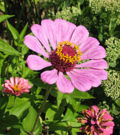
The daisy-like flowers are either single, semi-double, or double and can be large in size. The plant grows up to 75cm in height, but dwarf varieties exist.
Sow seeds in March in gentle heat and plant out in early June in enriched, multipurpose compost.
CONCLUSIONS
In this article what plants can be grown for sunny and dry conditions have been discussed. The range covered in this article covered mainly annuals but some perennials have been highlighted. It is quite difficult to get plants to flourish in hot and dry conditions, but the plants highlighted in this article will certainly match this brief.
If the UK starts getting drier summers, we may have to start rethinking about which plants can provide colour and interest in that time of year.
We may see some plants start to disappear but this is okay as new plants can be grown in their place.
If you have any questions or comments that you want to make, please do so in the comment box below.
Stay sunny and dry.

Hi there,
First of all: fantastic and thoroughly written article! I live in The Netherlands and the weather has been increasingly more dry over the last few years. My mother in law is a real garden freak and she always manages to keep her garden alive and well. I will be referring her to your website, as there’s a lot of information that might be useful to her!
Have a great day.
Hi Kevin
Greetings from old blighty. Give your mother in law all my blessings and wishes for the forthcoming growing season we gardeners in the future may need to change the way we garden and growing in sunny and fry conditions can be problematic, hence why this article was written. I want to give people choice.
Kind regards
Antonio
I come back here always with a smile on my face. All this plants are amazing. They are so different especially in this conditions. My favorite one is Cosmos. This brings me to the universe idea where all is infinite. The beauty of this flower is infinite! I know that this plant comes from Mexico because here it has all the conditions necessary to survive. The white one is amazing, just imagine a field full of these white flowers.
Thanks a lot and i wish you all the best !
Hi Nimrodngy
I like to give my readers a wide range of choice. More choice means you have more feast for the eyes. Cosmos is such an attractive plant with attractive foliage. It is a mainstay of the container garden and enjoy growing it amongst my other annuals is such a pleasure.
Kind regards
Antonio
This is a really great post and I must say that this is of high importance in the aspect of getting the plants that can withstand this sunny days that cab kill other plants. There are specific plants for specific periods. This is great and I would attach more significance to making good use of it. Thanks for sharing, I really like some of the plants
Hi RoDarrick
Thank you for stopping by and commenting once again. I really enjoy writing these articles that help people as much as possible. Growing in sunny and dry conditions can be challenging, and if you get it wrong you can kill a lot of plants.
These are tough plants.
Kind regards
Antonio
Getting the right plants that can be of all the season especially the one that can withstand the hot sun is good to see. Thank you for sharing here. I really wish that we can get more plants that can go for all seasons and all. This is really great and helpful. Thank you so much for sharing here
Hi Julianne
I am glad that I could help. Wishing you all the best.
Antonio
Gazania flowers are beautiful, I love them! I’ve seen them last year when I was in vacation, but I didn’t know how they were called, so I couldn’t find them. I’ll try to find some seeds for my garden.
It’s pretty sunny here during the summer, so I hope they will grow. 😀
Hi Alicia
The range of colours from Gazanias are so beautiful. The plants are so attractive that they look good in any container, along with the many others that I have suggested.
Kind regards
Antonio